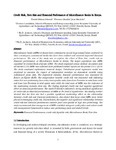| dc.description.abstract | Microfinance banks (MFBs) in Kenya have continued to record huge annual losses contrarily to their counterpart, commercial banks that have been resilient and reported improved financial performance. The aim of the study was to explore the effect of Firm Size, credit risk on financial performance of Microfinance banks in Kenya. The target population was MFBs regulated by Central Bank of Kenya (CBK). The study employed census method. Secondary data for thirteen (13) MFBs was collected from published annual reports for the period 2011-2019. The study employed explanatory research design. Unbalanced panel regression model was employed to examine the impact of independent variables on dependent variable using unbalanced panel data. The dependent variable, financial performance was measured by Return on Equity (ROE). The independent variable credit risk was measured with following ratios Net non-performing loan ratio, Asset quality ratio, Loan Loss Provision to total Loan ratio and Loan Loss Provision to total equity ratio while the total asset of MFBs was the indicator of the moderating variable, firm size. The finding depicted Credit risk had negative significant effect on financial performance. The model F statistics indicated a strong statistical significance of credit risk on financial performance of MFBs at 5% level of significance. The finding further showed that the firm size had a positive significant moderating effect on the relationship between credit risk and financial performance, thus depict that large sized MFBs were better placed in managing credit risk. Inconclusion, the negative and significant relationship between credit risk and financial performance indicate poor asset quality or high non-performing. The study recommends that management of MFBs establish stringent credit policy and robust credit risk management framework to reduce non-performing loans and default levels. | en_US |

